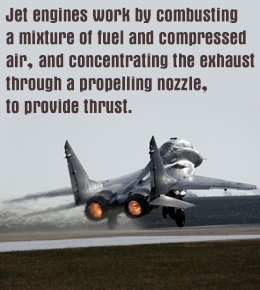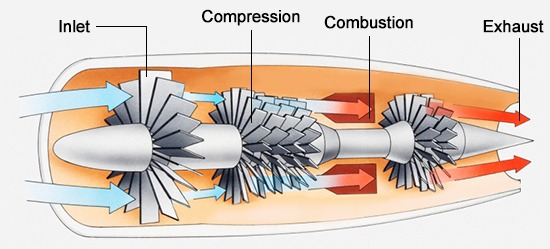
Did You Know?Jet engines are often identified exclusively with aircraft, but the world land speed record was also set by a jet-powered car.Jet power was known to man since a long time ago, but little could be achieved from it with the technological advances – or rather the lack of such – of that time. A jet-powered toy called the aeolipile, dating back to the 1st century AD, was found in Greece, but it served no practical purpose. Jet power was only truly harnessed after the Chinese invention of gunpowder, and subsequently rockets. The jet power in these instruments was very crudely employed, and was not very efficient.
As man conquered the hurdle of flight, propeller-driven aircraft became the order of the day. But soon, aviators realized that propellers could never exceed the sound barrier, and would thus remain inherently slow. This led to the clamoring for alternative methods of propulsion.
The first practical jet engines, also called gas turbine engines, were built in the 20th century, in Britain and Germany. Frank Whittle and Hans Von Ohain are often credited as the inventors of the jet engine. Both had constructed similar engines around 1937, neither knowing about the other’s work, but Ohain’s was the first to actually power an aircraft―the Heinkel He 178. Jet engines really came into their own after WWII, which, incidentally, was marked by the tussle between the propeller-powered Messerschmitts and Spitfires in the Battle of Britain. By the 1960s, most commercial airliners had installed jet engines on their fleets. Various types of jet engines are now also used to power spacecrafts and ballistic missiles.
How Do Jet Engines Work?
Jet engines work according to Newton’s third law of motion: Every action has an equal and opposite reaction. This principle is used in jet engines to generate thrust from jet propulsion. They are propelled forward (reaction) by the rearward flow of the exhaust jet (action).

Basic Design Of a Jet Engine
Functionally, the internal composition of jet engines is quite similar to your car’s 4-stroke engine. Jet engines also carry out the 4 strokes of intake, compression, combustion, and exhaust, but in different sections of the engine. Referring to the figure, the intake is responsible for constantly sucking in fresh air. The compressor, which is located in a narrower section of the engine, compresses the air, making it denser and warmer. In the combustion chamber, fuel is added to the compressed air, and the fuel-air mixture is ignited. The resulting blast of hot and extremely dense gases is then forced out of the propelling nozzle, which is the most essential component of a jet engine. The propelling nozzle is responsible for concentrating and directing the exhaust gases into a linear, powerful jet.
These hot, fast exhaust gases are used to turn a set of turbines. These turbines are connected to the compression fans by a shaft, allowing fresh air to be sucked in.
Turbojet engines, like the one shown in the image above, don’t have a separate fan at the front, and use all the available air for combustion. Turbofan engines, on the other hand, have a distinct fan at the tip of the assembly.

Turbofan Engine
The fan actively accelerates air into the compressor. This increases the amount of air available for combustion, and makes turbofan engines more fuel-efficient. Turbofan engines also incorporate ducts to allow some air to bypass the engine core. This enables the turbofan engine to use the thrust generated by the fan directly for propulsion.
Most modern turbofan engines employ a combination of the thrust generated by the engine, and the thrust generated by the fan itself. A higher preference to jet thrust makes the aircraft faster. This is used in military jet planes. On the other hand, a higher preference to fan thrust makes the aircraft a better cruiser and more fuel-efficient. This is used in commercial passenger planes.
► Ramjets and scramjets are specialized forms of the turbojet engine. They don’t have a fan at the front, or a central shaft utilizing the exhaust gases to power the fan. They simply have an inlet compressor, combustion chamber, and nozzle. Ramjets can’t be used from standstill, since they don’t have a mechanism to kickstart the procedure, and are only viably efficient at supersonic speeds. They are employed in missiles. Scramjets, or supersonic combustion ramjets, a derivative of the ramjet, are still under research from avionics and space research institutes, as a possible supersonic mode of travel.
► Rockets use jet propulsion in a slightly different way than turbojets, turbofans, and ramjets, whereas, the previously listed jet engines sucked in air and used it in combustion, rockets carry all propellants within their storage, and don’t suck in fresh air. The engines that suck in air are thus called air-breathing jet engines. While rockets may seem inefficient in contrast to other fuel-efficient jet engines, they actually become extremely efficient at speeds higher than Mach 5.
► Jet engines score over reciprocating engines, such as the ones used in propeller-powered aircraft, in various ways. For a start, jet propulsion allows for much faster speeds than propellers. Jet engines are also incredibly efficient when it comes to their power-to-weight ratio, i.e., the ratio of the power produced by an engine to its weight. Reciprocating engines producing a comparable power output would have to be much more massive.
Jet power is considered by many to be the greatest innovation in flight since powered flight, and it is not hard to see why.